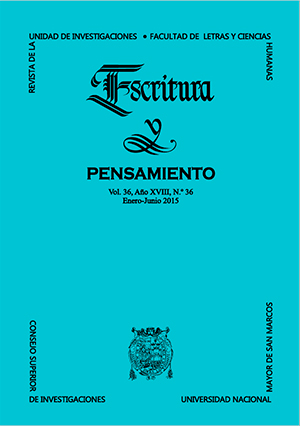LA LECTURA DEL CATOBLEPAS
DOI:
https://doi.org/10.15381/escrypensam.v18i36.13679Palabras clave:
intertextualidad, intratextualidad, catoblepas, Vargas Llosa, El héroe discreto.Resumen
Considerando el orden de publicación de las obras de Vargas Llosa, un lector podría reconocer características esenciales que conforman o delinean su poética. Sin embargo, en muchos casos, la interpretación que uno hace de una novela, por ejemplo, no termina solamente con la lectura autónoma de esta. El contenido se extiende cuando algunos aspectos de dicha obra se reconocen en una siguiente publicación. Es así como los espacios realistas, los roles que cumplen algunos personajes, las técnicas narrativas más usadas y la presencia, sobre todo, de personajes que reaparecen en más de una obra exigen la consideración de obras anteriores para ampliar la lectura. De esta forma, se tejen las relaciones intertextuales e intratextuales en su corpus literario.
En 2006, sustenté mi tesis de maestría titulada El verdadero catoblepas. Relaciones intertextuales en las obras de Mario Vargas Llosa. Tomé la figura mítica del ser que se alimenta de sí mismo parafraseando al autor, quien explica el origen de las historias que se cuentan en los libros. Mi adaptación de esta imagen se relaciona con la manera como las obras de Vargas Llosa se alimentan (en el sentido interpretativo) de la obra misma para desarrollar las interpretaciones del lector a partir de estas relaciones intertextuales. La teoría del 2006 se aplica en este artículo a la novela El héroe discreto publicada en 2013.
Descargas
Publicado
Número
Sección
Licencia
Los autores retienen sus derechos:
a. Los autores retienen sus derechos de marca y patente, y tambien sobre cualquier proceso o procedimiento descrito en el artículo.
b. Los autores retienen el derecho de compartir, copiar, distribuir, ejecutar y comunicar públicamente el articulo publicado en la revista Escritura y Pensamiento (por ejemplo, colocarlo en un repositorio institucional o publicarlo en un libro), con un reconocimiento de su publicación inicial en la revista Escritura y Pensamiento.
c. Los autores retienen el derecho a hacer una posterior publicación de su trabajo, de utilizar el artículo o cualquier parte de aquel (por ejemplo: una compilación de sus trabajos, notas para conferencias, tesis, o para un libro), siempre que indiquen la fuente de publicación (autores del trabajo, revista, volumen, numero y fecha).





